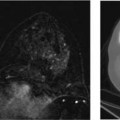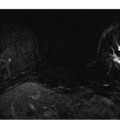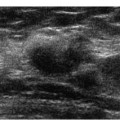7 Digital Mammographic Technique for Mammographic Asymmetries There are relatively limited data concerning the appearance of asymmetries on digital compared with screen-film mammography. The studies examining patients with both techniques have shown no significant difference in the identification of malignant asymmetries.1,2 The most common reason for discrepancies for all malignant assessments included fortuitous positioning and differences in diagnostic opinions.1 Because asymmetries tend to be more subtle than masses or calcifications, patient positioning may affect visualization of asymmetries more than these other lesions. However, neither positioning nor diagnostic opinion differentiates digital from screen-film technique. Asymmetries differ from masses in that they do not appear to have a three-dimensional volume. They lack convex borders, usually contain interspersed fat, and do not have a consistent shape in orthogonal planes.3 Asymmetries appear to represent a relative increase in the volume of fibroglandular tissue of the affected area compared with the contralateral region.4 Commonly, they are visible only on one screening view. There are two types of asymmetries: global and focal. Global asymmetries involve at least one quarter of a breast and are not palpable. About 3% of women have asymmetrical fibroglandular composition with symmetric breast volume.5 If global asymmetry represents asymmetry of normal fibroglandular tissue, then the tissue should have the same characteristics as normal fibroglandular tissue. The tissue lacks a specific shape. The area consists of curvilinear lines with interspersed fat. There are no convex borders or margins. Although some patients have asymmetric fibroglandular composition on their baseline exams, other patients develop global asymmetries with increasing age. Overall, fibroglandular composition commonly decreases with age and is associated with reduction in endogenous estrogen. This normal reduction in fibroglandular composition may result in either global or focal asymmetries. Besides physiologic causes for global asymmetry, medications may affect breast composition and produce global asymmetries. For example, hormone replacement therapy promotes estrogen effect on the breast and may increase fibroglandular composition.6,7 If the global asymmetry involves skin thickening, then one should consider etiologies such as axillary lymphatic obstruction, lymphatic spread of breast cancer, inflammation, postradiation effect, and systemic fluid overload.8 Axillary lymphatic obstruction results from surgical removal of axillary lymph nodes or is produced by malignancies such as metastatic axillary breast cancer and hematologic malignancies that block lymphatic drainage. Breast cancer sometimes metastasizes via lymphatic spread to the contralateral breast and produces lymphatic obstruction and lymphedema. Besides lymphatic obstruction, skin thickening may be caused by excess fluid or edema. Abscess with associated inflammation will produce skin thickening. Because abscesses are commonly subareolar, the skin thickening and increased density are primarily around the areola and decrease toward the axilla. Finally, systemic fluid overload from etiologies such as congestive heart failure and renal failure may produce skin thickening. Because factors outside the breast commonly produce global asymmetries, the work-up of global asymmetries should include a good patient history that covers any personal history of breast cancer. Because of hormone therapy’s influence on the breast, this information should be included on the clinical questionnaire administered to patients prior to mammographic examination. If the patient is symptomatic, then the patient’s symptoms should be recorded. If skin thickening is present, then the patient should be questioned about personal history of malignancy, infection, and illnesses producing systemic fluid overload. If the patient is new to the mammographic facility, she should be questioned about availability of previous examinations, as comparison with earlier mammographic examinations are particularly useful to assess stability of asymmetry. If the global asymmetry is new, and the asymmetry cannot be identified as normal fibroglandular tissue or ascribed to a known etiology, then this asymmetry should be evaluated using the same methods as a focal asymmetry. Focal asymmetries are smaller than global asymmetries. With high-contrast digital postprocessing, focal asymmetries are frequently visible. Comparison with previous examinations is important to determine if the asymmetry is a developing density. Because asymmetries are difficult to differentiate from surrounding fibroglandular tissue in more than one view, malignancies that appear in this manner tend to be the most difficult ones to detect. Like global asymmetry, the focal asymmetry is evaluated to determine if it is normal asymmetric fibroglandular tissue or a mass. Besides lacking defined shape, margins, and conspicuity, normal fibroglandular tissue consists of curvilinear lines interspersed with tiny islands of fat that are directed to the nipple. If the asymmetry is on the periphery, the edges of the asymmetry gradually fade in a feathery pattern into the surrounding fat. One should evaluate the asymmetry for associated factors that strongly suggest the presence of a mass such as architectural distortion, calcifications, or associated palpable lump. If a focal asymmetry is suspicious, the lesion should be characterized and localized. Spot compression mammography applied on a focal asymmetry can confirm the presence of a mass by clarifying the shape, margins, and position of the abnormality.9,10 However, spot compression has several weaknesses, including poor characterization of subtle masses and poor localization of masses visible only in one view. Furthermore, spot compression requires a technologist with skilled mammographic technique. Masses that initially appear as focal asymmetries tend to be subtle. This subtle appearance may be due to small size, obscuration of the mass by dense surrounding fibroglandular tissue, or increased compressibility. If the asymmetry represents a small mass surrounded by fibroglandular tissue, compression of the mass may not separate it from the surrounding density. If the asymmetry is compressible, as with some lobular carcinomas, then the lesion may not be visible with spot compression views because it will be “pressed out.” Besides inadequately characterizing subtle masses, spot compression views may not effectively localize focal asymmetries visible in only one screening view. In these cases, multiple spot compression views may need to be performed to identify the lesion. Many times, even after multiple attempts, the asymmetry is not clearly identified on an orthogonal view. The final disadvantage of spot compression views is that this technique is operator dependent. Although digital mammography allows for more flexibility in imaging parameters, for subtle lesions, the mammography technologist should place the mass in the middle of the spot compression field for optimal visualization. This placement may not be difficult when the asymmetry is easily visible. However, if the asymmetry is subtle or visible in only one view, then placement of a poorly visible asymmetry is difficult. Other techniques used to evaluate focal asymmetries are alternative localizing views (90 degrees, either mediolateral [ML] or lateromedial [LM] and exaggerated craniocaudal [XCCL] views), rolled craniocaudal (CC) views, and shallow mediolateral oblique (MLO) views. If the location of the focal asymmetry is clear, then the ML or LM and XCCL views are useful to further localize the asymmetry for future sonographic evaluation or biopsy.
 General Evaluation of Mammographic Asymmetries
General Evaluation of Mammographic Asymmetries
Stay updated, free articles. Join our Telegram channel

Full access? Get Clinical Tree





